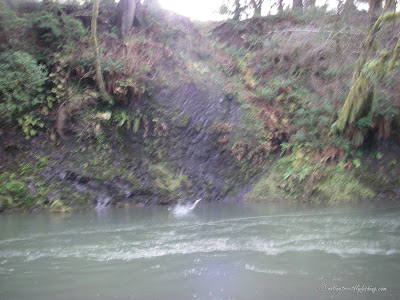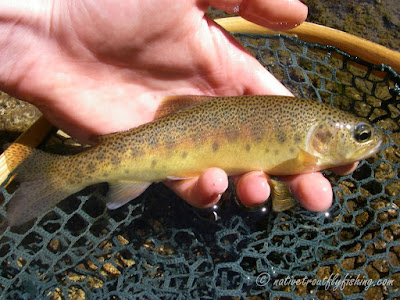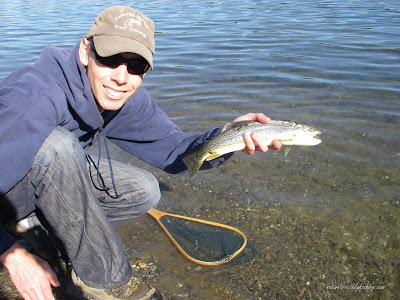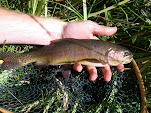After our last trip out to the Olympic Peninsula, Chris and I have been itching to get back out there. After several days of watching flows, when we both finally had a day off again and while river levels weren't ideal, we decided to go for it anyway. With that we met up at 4:00 AM and were on our way for another day of steelheading.
 |
| The river - high and off color |
Upon arriving at the river it quickly became clear that the flow and clarity were going to be an issue. In fact when we forded a tail out to get to one of our favorite holes there was only about eight inches of visibility. This meant that bright flies were likely bring us the best chances of success, so I rigged up with a nymph that I came up that has a copious amount of pink UV flash in it, followed by a glue egg. This step up definitely made a good dirty water nymphing rig as Chris noted that all he could see an orb of pink as it drifted by.
 |
| Covering the water |
We pounded the water in the stretch for several hours, but didn't see any signs of fish and it seemed like the water was just to high, so we decided to move downstream a bit further. We covered the entire next several hundred yard stretch downstream and Chris got one take down, but that was it. It was at this point that Chris pointed out that he had yet to drink his Red Bull and that this fact was putting a crux on our fishing. Sure enough, I had only made a couple of casts after he cracked his Red Bull open and made a drift into a slot between a couple of boulders when my indicator went down. I set on it and at first thought that it was just bottom as it didn't budge, then the fish realized it was hooked and took off.
 |
| Red Bull = steelhead??? |
The first thing that I noticed was that this fish was was much bigger than the one that I had gotten on our last trip. It also seemed to be quite a bit stronger. The fish ran me up and down the tail out a couple of times before I got it close enough to see that it was a nice about 9 lb chrome wild buck Steelhead!! Wild Steelhead are a very special fish and with the dwindling populations of these fish across the Pacific Northwest all of them should be released unharmed. Due to this fact Chris and I were extra careful with this fish and that meant that when the fish decided that it didn't want a photograph take it got its way. I was thrilled to have a had the opportunity to catch a fish a wild Stelhead and watch it swim away again to hopefully continue on to the spawning grounds.
I made a few more casts while Chris finished up his Red Bull and hooked into another fish just in front of where other one had been holding. However, I only got a couple of head shakes out of that fish before it tossed my fly.
With that it was Chris' turn. Chris was fishing his new switch rod and while I could only reach the middle of the river with my single hander he was able to get to the seam on the far side. After a couple of casts his indicator went down and for a second I thought that had a good hookup, but like my last fish this one too was able to toss his fly. However, a few casts later Chris found another fish and this time got a solid hook up on it.
 |
| Chris hooked up |
Chris fought his fish for a while, but while mine had decided to simply stay in the tail out, his decided to head downstream. Chris followed the fish down and had to work to keep the fish out of the rocks and snags along the bank, but brought the 6lb wild buck Steelhead within tailing range before long. Once again we were being very careful with this fish since it was wild and just as Chris went to tail it the hook popped out and the fish slipped back into the current.
After the short distance release of Chris' fish, we covered the pool for another a couple of hours, but it seemed that the effects of the Red Bull had worn off so we decided to go try some new water.
The first spot we went to was a deep hole with a big eddy one our side of the river. We had only been here a couple of minutes when a fish rolled in the eddy. Chris tried a few casts but didn't get any grabs on the inside of the eddy so he started working the seam on the edge. With that I took the inside and watched as the unknown fish rolled again. The current was pretty slow here so I was giving my fly some sporadic twitches downstream followed by a dead drift to give it a little extra action. I was in the dead drift part of this routine when my indicator started to move slowly upstream. I set on it and the water erupted as about a 10lb Coho broke the surface. After a short battle (very short compared to the Steelhead) I brought the fish in, pulled the UV Bomber fly out of its jaw and turned it loose. We spent a little more time fishing this stretch after I released the Coho, but we still wanted to check out a hike in section of the river, so before long we headed out again.
 |
| The culprit - a wild hen Coho |
We picked a stretch of river about a 1/2 mile from the road and found a nice hole were a tributary dumped in. While we saw a couple of fish roll in this stretch the only thing that we got out of it was some lost flies so we kept moving downstream.
 |
| Chris working some of the hike in water |
We covered a few nice runs downstream with no luck before the banks became to steep to continue and we had to turn around. While there was some nice water down in this section it would definitely fish better with less water, like most of the river.
 |
| The hike out was a bit steep... |
After checking out the hike in water, we still had a little bit of daylight so we decided to head downstream and try out one more spot. However, while we did see a few fish roll, the amount of daylight just didn't allow us enough time to properly cover the water and we had to call it a day.


























































